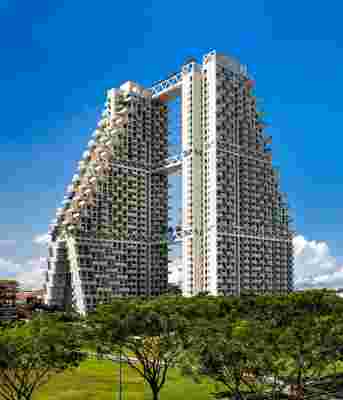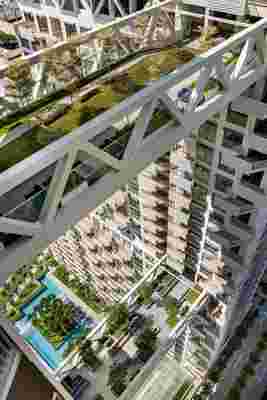Safdie Architects —a firm that first gained fame with its experimental design, Habitat 67, at the 1967 World’s Fair in Montreal—recently completed a residential complex in Singapore. Located six miles from the city-state’s downtown, the 38-story structure isn’t far from the firm’s most renowned building in Singapore, the Marina Bay Sands Hotel. The newest project, however, is striking for two main reasons. By breaking down the scale of a typical tower block, the design, from afar, forms a seemingly pixelated series of apartment units, each featuring a private terrace. The complex, which consists of two buildings, is connected by three bridges, providing residents with a variety of common areas for recreation and congregation. The two lower bridges are lined with trees and plants that bring a sense of nature into the structure, as well as walkways and chairs where residents can stroll or sit and enjoy the surrounding views. At the very top of the building is the third bridge, which features a swimming pool nearly 400 feet in the sky. Views from this, the highest point in the complex, are sure to be quite spectacular.
“I think you need to, as an architect, understand the essence of a place and create a building that feels like it resonates with the culture of a place,” said Moshe Safdie, the firm’s founder, in a statement. As such, in order to maximize air movement in the region’s tropical climate, the structure was designed to allow cross-ventilation and provide multiple exposures for each unit. And for those who like the gardens that the sky bridges provide but want to be surrounded by even more nature, Singapore’s famous botanical garden is a mere ten-minute drive from Safdie’s new complex.

Safdie Architects’ newest residential building stands out in Singapore’s skyline for its unique fractal-based design.

The two lower sky bridges are lined with trees and chairs for residents of the building to enjoy.
